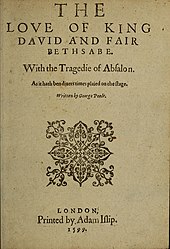David and Bethsabe

The Love of King David and Fair Bethsabe is a play by George Peele, based on the biblical story of David, Bathsheba, and Absalom in 2 Samuel. Probably written in the early 1590s, it was entered into the Stationers' Register on 14 May 1594 and published in 1599, after Peele's death, by the printer Adam Islip.[1] The 1599 quarto is problematic in many respects: inconsistencies and internal contradictions, as well as one obviously misplaced fragment of a scene, have led some scholars to conclude that it is a shortened and revised version of an originally longer work.[2]
The full title of the play, as it appears on the title page of the 1599 quarto, is The Love of King David and Fair Bethsabe, with the Tragedie of Absalon, and in its surviving form David's relationship with his sons, Absalom in particular, is the main focus of attention, rather than relationship between David and Bathsheba.[3] Peele follows the narrative in the book of Samuel closely, but it was not his only source: he also imitated and adapted a number of passages from the Semaines of the French religious poet Guillaume Du Bartas (1544–1590).[4]
Although few examples survive today, plays based on stories from the Bible were not uncommon in the English Renaissance theatre. Over a dozen are known to have been produced between 1588 and 1602 alone, from titles and production details preserved in sources such as the Stationers' Register and the diary of Philip Henslowe.[5] Unlike late mediaeval mystery and morality plays, which used biblical material in very different ways, most of the lost biblical plays of the late 16th century focused on the soldier kings and prophets of the Old Testament, and reflect the political interests and theatrical conventions of other Elizabethan historical dramas.[6]
Notes[edit]
- ^ Chambers 1923, p. 461; Blistein 1970, pp. 139–143, 153–155; ESTC S110364.
- ^ Sampley 1931; Blistein 1970, pp. 177–182.
- ^ Connolly 2007.
- ^ Sykes 1924; Blistein 1970, pp. 143–152.
- ^ Connolly 2007, table in the appendix.
- ^ Connolly 2007; Connolly 2019, p. 31.
References[edit]
- Blistein, Elmer, ed. (1970). "David and Bethsabe". The Life and Works of George Peele. Vol. 3. New Haven: Yale University Press. pp. 133–295. ISBN 9780300011852.
- Chambers, E. K. (1923). The Elizabethan Stage. Vol. 3. Oxford: Clarendon Press. p. 461.
- Connolly, Annaliese (2007). "Peele's David and Bethsabe: Reconsidering Biblical Drama of the Long 1590s". Early Modern Literary Studies. Special volume 16 (The Long 1590s).
- Connolly, Annaliese (2019). "Biblical tragedy: George Peele's David and Bethsabe". In Cadman, Daniel; Duxfield, Andrew; Hopkins, Lisa (eds.). The genres of Renaissance tragedy. Manchester University Press. pp. 29–50. ISBN 978-1-78499-279-8. JSTOR j.ctv18b5jhg.6.
- Sampley, Arthur M. (1931). "The Text of Peele's David and Bethsabe". PMLA. 46 (3): 659–671. doi:10.2307/457853. JSTOR 457853. S2CID 163651176.
- Sykes, H. Dugdale (1924). "Peele's Borrowings from Du Bartas". Notes and Queries. 147: 349–351, 368–369. doi:10.1093/nq/CXLVII.nov15.349.
External links[edit]
Quarto of 1599: scan (Internet Archive) and transcription (EEBO-TCP)
